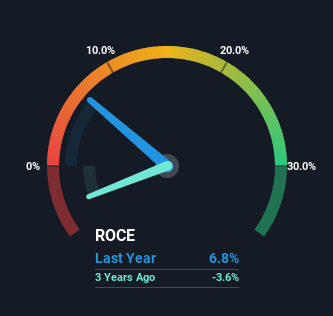- United Kingdom
- /
- Hospitality
- /
- LSE:MAB
Slowing Rates Of Return At Mitchells & Butlers (LON:MAB) Leave Little Room For Excitement

If you're not sure where to start when looking for the next multi-bagger, there are a few key trends you should keep an eye out for. Firstly, we'll want to see a proven return on capital employed (ROCE) that is increasing, and secondly, an expanding base of capital employed. If you see this, it typically means it's a company with a great business model and plenty of profitable reinvestment opportunities. In light of that, when we looked at Mitchells & Butlers (LON:MAB) and its ROCE trend, we weren't exactly thrilled.
Return On Capital Employed (ROCE): What Is It?
For those that aren't sure what ROCE is, it measures the amount of pre-tax profits a company can generate from the capital employed in its business. Analysts use this formula to calculate it for Mitchells & Butlers:
Return on Capital Employed = Earnings Before Interest and Tax (EBIT) ÷ (Total Assets - Current Liabilities)
0.068 = UK£310m ÷ (UK£5.2b - UK£662m) (Based on the trailing twelve months to September 2024).
So, Mitchells & Butlers has an ROCE of 6.8%. On its own that's a low return on capital but it's in line with the industry's average returns of 7.4%.
Check out our latest analysis for Mitchells & Butlers

In the above chart we have measured Mitchells & Butlers' prior ROCE against its prior performance, but the future is arguably more important. If you'd like, you can check out the forecasts from the analysts covering Mitchells & Butlers for free.
What The Trend Of ROCE Can Tell Us
There hasn't been much to report for Mitchells & Butlers' returns and its level of capital employed because both metrics have been steady for the past five years. It's not uncommon to see this when looking at a mature and stable business that isn't re-investing its earnings because it has likely passed that phase of the business cycle. So don't be surprised if Mitchells & Butlers doesn't end up being a multi-bagger in a few years time.
The Bottom Line On Mitchells & Butlers' ROCE
In a nutshell, Mitchells & Butlers has been trudging along with the same returns from the same amount of capital over the last five years. And with the stock having returned a mere 33% in the last five years to shareholders, you could argue that they're aware of these lackluster trends. As a result, if you're hunting for a multi-bagger, we think you'd have more luck elsewhere.
One more thing, we've spotted 1 warning sign facing Mitchells & Butlers that you might find interesting.
For those who like to invest in solid companies, check out this free list of companies with solid balance sheets and high returns on equity.
New: Manage All Your Stock Portfolios in One Place
We've created the ultimate portfolio companion for stock investors, and it's free.
• Connect an unlimited number of Portfolios and see your total in one currency
• Be alerted to new Warning Signs or Risks via email or mobile
• Track the Fair Value of your stocks
Have feedback on this article? Concerned about the content? Get in touch with us directly. Alternatively, email editorial-team (at) simplywallst.com.
This article by Simply Wall St is general in nature. We provide commentary based on historical data and analyst forecasts only using an unbiased methodology and our articles are not intended to be financial advice. It does not constitute a recommendation to buy or sell any stock, and does not take account of your objectives, or your financial situation. We aim to bring you long-term focused analysis driven by fundamental data. Note that our analysis may not factor in the latest price-sensitive company announcements or qualitative material. Simply Wall St has no position in any stocks mentioned.
About LSE:MAB
Mitchells & Butlers
Engages in the management of pubs, bars, and restaurants in the United Kingdom and Germany.
Solid track record with adequate balance sheet.
Similar Companies
Market Insights
Community Narratives





